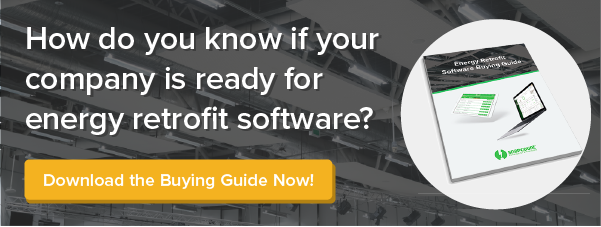
Lighting retrofit companies have two basic options when it comes to commercial energy audit software. You can either develop your own software or purchase software from a third party.
The do-it-yourself route does have a certain appeal. When you develop software in-house, you can tailor it to your firm’s specific needs and workflow — in theory, anyway.
The truth is, lighting retrofitters are not software developers, and those that undertake the challenge often run into unforeseen hurdles.
Many companies that build their own lighting audit software wind up realizing their time and money would have been better spent investigating commercially available alternatives.
SnapCount user David Krueger offers one such cautionary tale.
Long before his current role as president and chief financial officer of IoEnergy, Krueger was president of a publicly traded energy efficiency and sustainability company. That company decided to develop auditing software internally.
Krueger’s experience with a home-brewed solution led him and his executive team to choose SnapCount when they founded IoEnergy.
We asked Krueger to walk us through IoEnergy’s decision — and how SnapCount has helped his company — in his own words.
Q: Before starting IoEnergy, you ran another company that used custom-built lighting audit software. Why did you initially choose that route?
David Krueger: At the time, it was our only option. My experience in the industry goes back to when there were no software applications. In the 2000s, the earliest SaaS solutions, such as QuickBook and Salesforce.com, came online, but they were all very expensive. It would have cost a lot to hire the equivalent of a Salesforce developer to create the lighting audit software we had in mind, so we ended up building our own in-house.
I’m not a tech guy, but I know it involved Access databases, Excel and a lot of programming. We spent around $2.2 million in overhead, time, and expense to build this software. And from there, it required four or five full-time people to keep it alive.
Q: When did things start going wrong with the custom-built software?
Krueger: It never really accomplished what we wanted it to do. The software definitely protected us on pricing and project margin, but it didn’t really help us on business development and automation of the proposal process — which was the software’s intent. It just wasn’t that good at the end of the day.
One major issue was the time it took for new users to learn the software. When you’ve got 50 full-time salaried salespeople trying to use this technology, you lose sales productivity to training. We had weeks of training, and we had to pay to fly everybody in to train them. That’s extremely valuable time we were losing.
I wouldn’t call it a fail, because this company used this software for a long time. Because we had expended capital on developing this asset, it wasn’t easy to undo that and go to something else. No one wanted to write down $2.8 million in a short period of time. When I left the company in 2012, they were still using the custom-built lighting auditing software, and they might still be using it to this day.
Q: Did you consider creating your own lighting audit software when you founded IoEnergy?
Krueger: In the beginning, we just kind of muscled through the way we did back in the ’90s, using Excel spreadsheets. We weren’t doing a tremendous amount of volume to start, so the spreadsheet method worked for a while. But it soon became apparent that that approach wouldn’t be scalable.
Q: Given your experience with underperforming software at your previous firm, what capabilities did you prioritize in your search for a commercially available software solution?
Krueger: Simplicity and intuitive use were critical to what we were looking for.
A friendly competitor introduced us to SnapCount, and we discovered the SnapCount team had a knowledge base, knew what they were doing, and had built a unique niche market product.
We’re not programmers, and we’re not software people. When we tried SnapCount, it became apparent pretty quickly that it’s intuitive to non-techy people. I thought, “OK, If I can do this, I know our team can do this.”
Q: What else convinced you to choose SnapCount? Were there any other contenders?
Krueger: One of my concerns was, “If I’m going to make this investment of time to transition my company over to this platform, I really need the platform to still be here in a couple of years.”
I think we’ve crossed that line of confidence with StreamLinx (the makers of SnapCount). The company’s stable, the executive management team of the company’s stable. SnapCount is leading this market and being very successful, and that’s who we want to be with.
We were approached by another software vendor early on, but the company did not feel as viable to me, and frankly, the SnapCount product was superior by a wide margin.
Q: What has the IoEnergy team been able to accomplish using SnapCount that would have been difficult without it?
Krueger: SnapCount isn’t just a piece of software; it’s an ecosystem. We can hire anybody, anywhere in the country to perform an audit, and, using SnapCount, they can bring it back to me in the format that we’re accustomed to working with, as if our own people were doing it.
If we were using a proprietary system, that would be impossible. The ecosystem of SnapCount-trained auditors — that’s amazing. It’s a game-changer for our industry.
SnapCount also gives us the ability to manage scaled projects effectively. Any system we’ve used in the past was mainly useful for large single-site projects. When you’re doing a thousand sites across the United States, scaling that out and managing that data is absurdly difficult. SnapCount allows us to take on large-scale accounts and cost-effectively manage that data — both sales and construction work.
For example, we recently worked on a retrofit project for a real estate trust that had consolidated the ownership of 800 different mobile home communities. There was no consistency from one community to another, but we found the consistencies once we loaded the data onto the software platform.
Now, we standardize the data, and we standardize the output. Honestly, I wouldn’t have taken on a project like that before we started using SnapCount, because of the data management problem. It would have been undoable.
Is now the right time for your company to switch to a better software solution? Our Lighting Software Buying Guide walks you through the considerations, costs, and opportunities of upgrading from spreadsheets to a purpose-built lighting retrofit software.






Share this post: